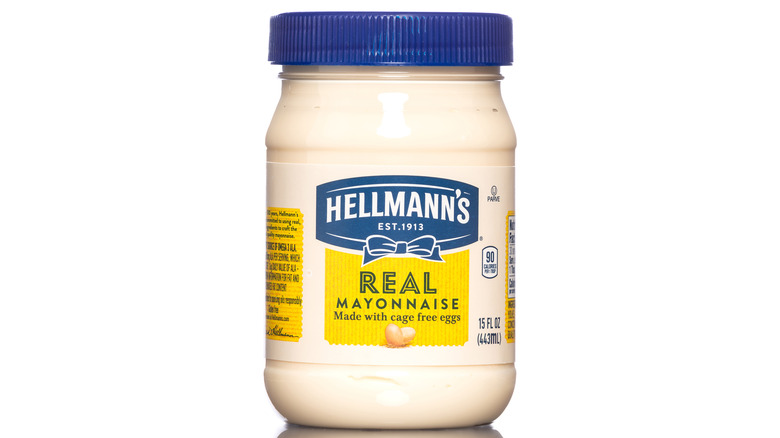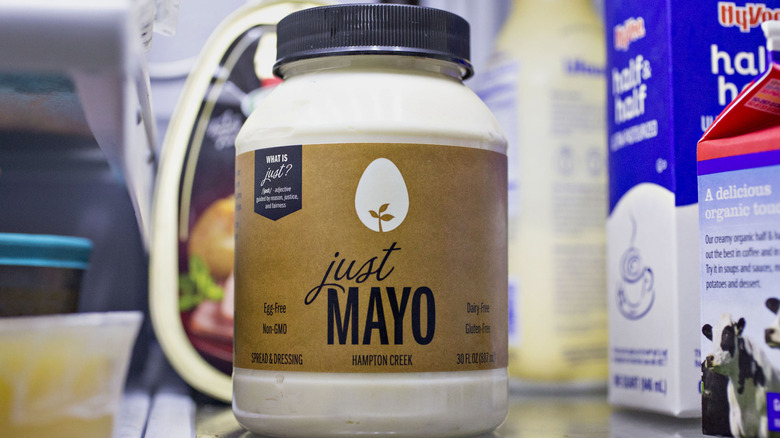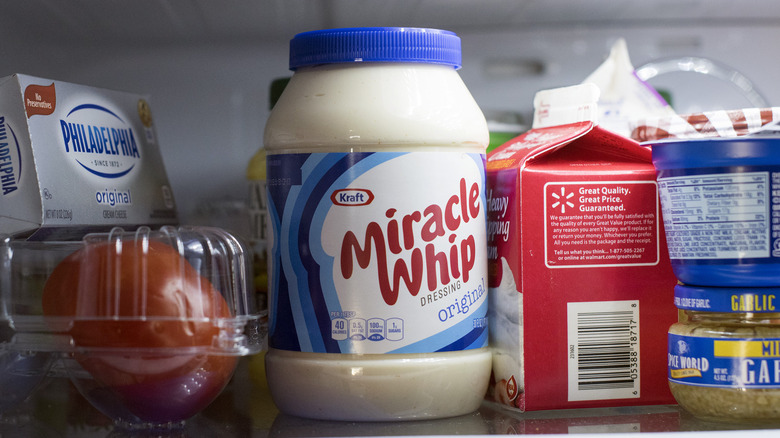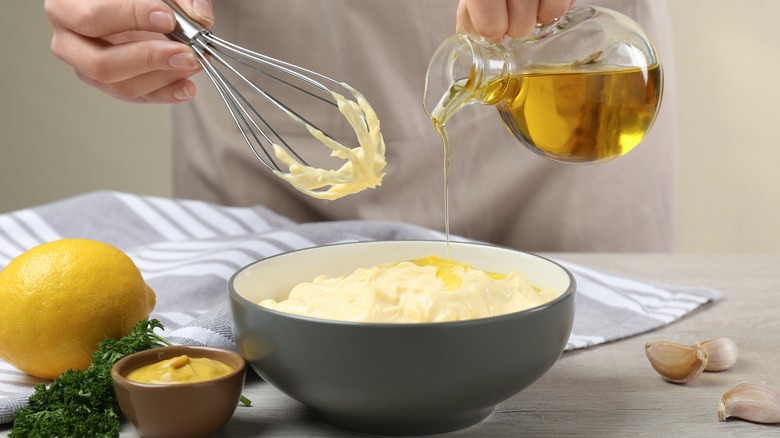The Reason Hellmann's Adds The Word 'Real' To Its Packaging
Anyone who's ever looked closely at a bottle of Hellmann's mayonnaise may have noticed that the label identifies it as "real mayonnaise." This might seem odd — after all, you likely haven't seen packages of ketchup or mustard with claims to realness slapped on the label. But in the case of mayonnaise, there's a reason why Hellmann's has done so, and it has to do with the U.S. Food and Drug Administration.
The FDA has a firm definition of what qualifies as mayonnaise. Specifically, it must contain vegetable oil and some form of egg yolk; there are also various details about what proportion of the mayonnaise must be oil, as well as rules about adding other ingredients like vinegar or lemon juice to the mix. If your product meets these rules, it can use the term "mayonnaise" on its label; if not, it needs to be called something else. In the case of Hellmann's, the company isn't required to add the word "real" to its label: The fact that it's called "mayonnaise" already indicates that it meets the FDA requirements. However, by adding the word "real," the company is presumably looking to advertise the fact that it meets these requirements, and is a bonafide mayonnaise — at least in the eyes of the government.
The slightly confusing vegan mayo labeling debate
So to use the term "mayonnaise" on packaging in the U.S., you need to have both oil and eggs in there — but just to make things extra complicated, companies may be able to affix "mayo" to the label without actually meeting the FDA's requirements. In 2015, the FDA warned food company Hampton Creek (now named "Eat Just") for the labeling on its vegan "Just Mayo" product, which did not contain eggs. The FDA complaint against Hampton Creek was sparked by a lawsuit from Unilever, the multinational giant that owns Hellmann's. The company was ordered to refrain from using terms like "mayo", but the FDA and Hampton Creek discussed the issue and the FDA changed course, allowing it to keep using the term. It's also unclear if the full term "mayonnaise" is allowed, although the FDA has suggested it regards "mayo" and "mayonnaise" as the same.
Hampton Creek still had to make some changes to its labeling, though. The company agreed to make the words "egg-free" larger on its packaging, and to shrink an image of an egg with a plant shoot coming out of it, to make it clearer that it was not your typical egg-and-oil mayonnaise, among other changes. As for Hellmann's, the company hasn't indicated why it puts the word "real" on its packaging, but it seems plausible that it's a strategy to differentiate itself from egg-free "mayonnaise," which is now able to use the same terminology.
The original fake mayonnaise
Of course, Just Mayo was not the first product to be roadblocked by the FDA's mayonnaise labeling rules. That honor goes to Kraft's Miracle Whip, which (as its jars clearly state) is officially a dressing, rather than mayonnaise. Miracle Whip was developed around the time of the Great Depression as a cheap mayonnaise substitute. Its ingredients are actually closer to the FDA requirements than Just Mayo: It contains the requisite eggs, oil, and vinegar, emulsified together, as well as some spices and sugar.
However, with less than 65% oil in its recipe, Miracle Whip still falls short of FDA requirements. In contrast to Just Mayo, Miracle Whip doesn't appear to have had any major lawsuits or widely-publicized disputes over its ingredients or marketing, since its packaging firmly avoids the M-word, and it's presented as a spread or salad dressing instead. While the Just Mayo case did prompt suggestions that Miracle Whip should be equally allowed to use a term like "mayo," the term is absent from its packaging, although most retailers keep it in the same section and will describe Miracle Whip as "mayo-like."
How to be sure of what you're getting
There are still gray areas around mayonnaise labeling after the Just Mayo case — for example, it's not quite clear what standards would be applied to other vegan mayo brands beyond Just Mayo, in terms of labeling or ingredients. Unfortunately, it seems there haven't been any complaints or lawsuits disturbing these waters since the Just Mayo case was resolved. So, how can you be sure that you're getting "real" mayonnaise?
You could try reading between the lines on the packaging — for example, based on the Hampton Creek case, it would make sense that the FDA would not allow a company to use the term "real mayonnaise" if it didn't contain eggs or otherwise meet FDA regulations. But this isn't a guarantee: For example, a company could be mislabeling its "faux mayonnaise," and the FDA either hasn't noticed or hasn't made a complaint yet. More obviously, think about a comparable situation, like with vegan milk: You can probably pick the difference between soy and cow milk by looking at the words on the packaging. But there's one easy way to be sure — look at the ingredient list and check if eggs are listed. You can even go full detective mode and check the entire ingredient list against the FDA rules. But in any case, if you want to guarantee that the basics (eggs and oil) are there, just check the back of the bottle.



